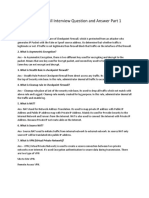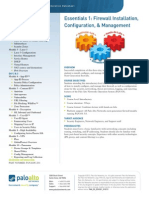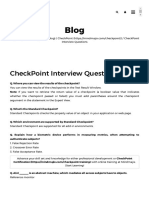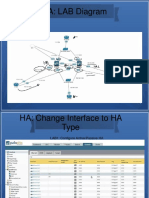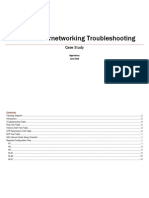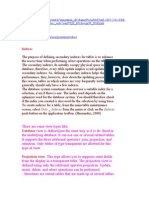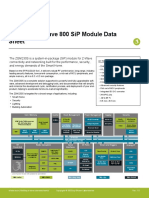0 ratings0% found this document useful (0 votes)
491 viewsPalo Alto Firewall Contents
Palo Alto Firewall Contents
Uploaded by
Khodor AkoumThe document outlines the contents of a Palo Alto Firewall PCNSE course, including installation and configuration of Palo Alto firewalls. It covers topics such as interface configuration, routing, NAT, security policies, logging, VPN deployment, high availability, authentication, and troubleshooting. The course aims to teach participants how to build a firewall lab from scratch and configure the various security services and features of Palo Alto networks.
Copyright:
© All Rights Reserved
Available Formats
Download as PDF, TXT or read online from Scribd
Palo Alto Firewall Contents
Palo Alto Firewall Contents
Uploaded by
Khodor Akoum0 ratings0% found this document useful (0 votes)
491 views4 pagesThe document outlines the contents of a Palo Alto Firewall PCNSE course, including installation and configuration of Palo Alto firewalls. It covers topics such as interface configuration, routing, NAT, security policies, logging, VPN deployment, high availability, authentication, and troubleshooting. The course aims to teach participants how to build a firewall lab from scratch and configure the various security services and features of Palo Alto networks.
Original Description:
Palo Alto Firewall Contents
Copyright
© © All Rights Reserved
Available Formats
PDF, TXT or read online from Scribd
Share this document
Did you find this document useful?
Is this content inappropriate?
The document outlines the contents of a Palo Alto Firewall PCNSE course, including installation and configuration of Palo Alto firewalls. It covers topics such as interface configuration, routing, NAT, security policies, logging, VPN deployment, high availability, authentication, and troubleshooting. The course aims to teach participants how to build a firewall lab from scratch and configure the various security services and features of Palo Alto networks.
Copyright:
© All Rights Reserved
Available Formats
Download as PDF, TXT or read online from Scribd
Download as pdf or txt
0 ratings0% found this document useful (0 votes)
491 views4 pagesPalo Alto Firewall Contents
Palo Alto Firewall Contents
Uploaded by
Khodor AkoumThe document outlines the contents of a Palo Alto Firewall PCNSE course, including installation and configuration of Palo Alto firewalls. It covers topics such as interface configuration, routing, NAT, security policies, logging, VPN deployment, high availability, authentication, and troubleshooting. The course aims to teach participants how to build a firewall lab from scratch and configure the various security services and features of Palo Alto networks.
Copyright:
© All Rights Reserved
Available Formats
Download as PDF, TXT or read online from Scribd
Download as pdf or txt
You are on page 1of 4
Palo alto Firewall PCNSE Contents
● About PaloAlto company and products.
● How to build the course lab from scratch step-by-step
● Installation and initial configuration
● Configuring the Management interface and access to the Firewall
● Understanding and Configuring Interface Types:
- Layer3 interface !
- Layer2 interface !
- Tap interface !
- High Availability interface !
- Virtual Wire interface !
- Sub interface !
- Loopback interface !
● Configuring DNS
● Understanding and configuring DNS Proxy.
● Configuring NTP and IP Proxy
● DHCP service configuration
- DHCP Server !
- DHCP Relay Agent service !
● Introduction and Configuration of security zones.
● Virtual Router
● Reset the firewall (Factory Defaults) and reset the admin password
● Administrator Type (Dynamic)
● Administrator Type (Role Based)
● Routing
- Static Routing.
- Dynamic Routing (RIP, OSPF, BGP)
● Bidirectional Forwarding Detection (BFD)
● Policy Based Forwarding (PBF)
● Understanding and configuring different NAT types:
- Static NAT
- Dynamic NAT
- PAT
- Port forwarding
- U-turn NAT
● Understanding and creating different types of Objects.
● Security policy
● Managing Logging
● Application policy
● URL Filtering
● File control
● Anti-virus configuration
● Anti-Spyware configuration
● Security Profile Groups
● Schedules
● Managing Netflow
● SSL decryption and inspection
- What is encryption and decryption !
- How SSL works !
- Differences between SSL and IPSec !
- How SSL traffic can be decrypted !
● Integration with Active Directory and LDAP profiles.
● Managing Captive portal
● Palo Alto Passive Authentication Configuration
● Understanding and Configuring SNMP
● Managing logging
● Virtual Wires deployment
● Virtual Private Network (VPN)
- What is VPN ! and why used !
- How VPN works in general !
- VPN types !
- Deploying Site to Site VPN !
- Deploying Remote Access VPN !
● Understanding and deploying High availability
- AA (Active/AActive) high availability
- AP (Active/Passive) high availability
● Zone Protection Profiles
● DoS protection
● Vulnerability protection (protect vulnerable systems)
● Data filtering
● RADIUS Server Authentication
● TACACS+ Authentication.
● Traffic capture
● Palo Alto WildFire
● Palo Alto backup
● Configuration Management.
- Candidate configuration
- Running configuration
- Saved configuration
● Common troubleshooting commands
● QoS policy
● Application override policy
● Understanding Palo Alto Virtual Systems
● Panorama
You might also like
- Palo Alto Syllabus PDFDocument1 pagePalo Alto Syllabus PDFbhpyforeverNo ratings yet
- Final Report On Chat Application Using MernDocument50 pagesFinal Report On Chat Application Using MernwatahNo ratings yet
- Tech Note - GlobalProtect - TroubleshootingDocument14 pagesTech Note - GlobalProtect - TroubleshootingJhonnySinatraNo ratings yet
- DLP 15.1 Install Guide PDFDocument160 pagesDLP 15.1 Install Guide PDFRishabh KushwahaNo ratings yet
- Practice Question Palo AltoDocument20 pagesPractice Question Palo AltoCarlos Ivan Donoso Osorio0% (1)
- Checkpoint Firewall Interview Question and Answer Part 1Document4 pagesCheckpoint Firewall Interview Question and Answer Part 1Files DownNo ratings yet
- 201-Essentials 1 - Firewall Installation Configuration and Management-5Document1 page201-Essentials 1 - Firewall Installation Configuration and Management-5Abirami SundaramNo ratings yet
- ClearPass OnGuard TroubleshootingDocument90 pagesClearPass OnGuard TroubleshootingEduardo ParedesNo ratings yet
- Fortigate Ipsec VPN 52 - 2Document240 pagesFortigate Ipsec VPN 52 - 2Madhu ThamatamNo ratings yet
- Active Directory Migration Strategy A Complete Guide - 2020 EditionFrom EverandActive Directory Migration Strategy A Complete Guide - 2020 EditionNo ratings yet
- MTN - F5 Deployment PDFDocument12 pagesMTN - F5 Deployment PDFKhodor AkoumNo ratings yet
- Tech Note - PAN - L3-Config GuideDocument32 pagesTech Note - PAN - L3-Config GuideJhonnySinatraNo ratings yet
- 9.advanced CheckPoint Interview Questions and Answers 2017Document4 pages9.advanced CheckPoint Interview Questions and Answers 2017nagendra_badamNo ratings yet
- Azure Networking Basics Course ContentDocument61 pagesAzure Networking Basics Course ContentManoj PundirNo ratings yet
- Walkthrought IPAM in Windows Server 2012Document35 pagesWalkthrought IPAM in Windows Server 2012walter alvarenga100% (1)
- Design Implement and Manage An Azure Firewall Deployment SlidesDocument21 pagesDesign Implement and Manage An Azure Firewall Deployment SlidesggNo ratings yet
- FortiGate Interview Questions OnlyDocument4 pagesFortiGate Interview Questions OnlyWady L. BautistaNo ratings yet
- Pan-Os Cli Quick StartDocument44 pagesPan-Os Cli Quick StartdeltacraiovaNo ratings yet
- Ad - Idm, Netiq, Identity ManagerDocument130 pagesAd - Idm, Netiq, Identity ManagerAlex AeronNo ratings yet
- Palo Alto Next Generation FirewallDocument15 pagesPalo Alto Next Generation FirewallOm PalNo ratings yet
- ClearPass Deployment Guide - Mobility Access Switch Configuration For 802.1X Wired AuthenticationDocument4 pagesClearPass Deployment Guide - Mobility Access Switch Configuration For 802.1X Wired AuthenticationruphydNo ratings yet
- LG GIS Networking Network Data Admin L2Document4 pagesLG GIS Networking Network Data Admin L2Ashish Kumar JhaNo ratings yet
- Palo Alto Networks PlatformsDocument8 pagesPalo Alto Networks PlatformskumarNo ratings yet
- Checkpoint Packet FlowDocument3 pagesCheckpoint Packet FlowSurajKumarNo ratings yet
- Palo Alto Networks in The Datacenter PDFDocument9 pagesPalo Alto Networks in The Datacenter PDFRyanb378No ratings yet
- Configuring Firewall Settings For ConfigMgrDocument21 pagesConfiguring Firewall Settings For ConfigMgrjean-phileNo ratings yet
- Threat Prevention Deployment TechNote Version 3.0 RevADocument62 pagesThreat Prevention Deployment TechNote Version 3.0 RevAHenryNo ratings yet
- Azure Ad Lab GuideDocument65 pagesAzure Ad Lab GuideAshok TripathyNo ratings yet
- Device Integration Cisco WLCDocument6 pagesDevice Integration Cisco WLCSpyman_pcNo ratings yet
- Forcepoint NGFW SSL VPN Portal PDFDocument12 pagesForcepoint NGFW SSL VPN Portal PDFcnlNo ratings yet
- Palo Alto HA-LAB - Self PreparedDocument55 pagesPalo Alto HA-LAB - Self PreparedAkhlaq AfsarNo ratings yet
- VPN Interview Questions and AnswersDocument7 pagesVPN Interview Questions and AnswersMD IRFANNo ratings yet
- DNS Interview Questions and AnswersDocument4 pagesDNS Interview Questions and AnswersRavi SankasrNo ratings yet
- Internetworking Troubleshooting Case StudyDocument26 pagesInternetworking Troubleshooting Case StudyNigel Terry Sanou100% (1)
- Site To Site VPN Troubleshooting TemplateDocument3 pagesSite To Site VPN Troubleshooting Templatest_kannanNo ratings yet
- LDAP AttributesDocument4 pagesLDAP AttributesAlexandre HortaNo ratings yet
- PaloAlto - Lab - Part 3 BasicsDocument37 pagesPaloAlto - Lab - Part 3 BasicsanasseNo ratings yet
- Cisco AP 1142 ManualDocument518 pagesCisco AP 1142 Manualkrizanh100% (1)
- ASA Firewall Interview Questions and Answers (CCIE) - Networker Interview PDFDocument8 pagesASA Firewall Interview Questions and Answers (CCIE) - Networker Interview PDFBhupendar SinghNo ratings yet
- Palo Alto Networks Firewall Initial Configuration Tech Note PANDocument8 pagesPalo Alto Networks Firewall Initial Configuration Tech Note PANDesiré GohoréNo ratings yet
- Tech Note - Packet Based DebuggingDocument19 pagesTech Note - Packet Based DebuggingJhonnySinatraNo ratings yet
- Cisco IOS IP Configuration Guide: Release 12.2Document624 pagesCisco IOS IP Configuration Guide: Release 12.2eterrazas100% (1)
- Deploy AnyconnectDocument36 pagesDeploy AnyconnectPraveen RaiNo ratings yet
- BlueCoat Basic TroubleshootingDocument4 pagesBlueCoat Basic TroubleshootingopabolajoNo ratings yet
- Firepower FMC PDFDocument8 pagesFirepower FMC PDFnelsonjedNo ratings yet
- How To Configure Azure Route Tables (UDR) Using Azure Portal and ARMDocument11 pagesHow To Configure Azure Route Tables (UDR) Using Azure Portal and ARMAlok RanjanNo ratings yet
- Palo Alto 1 Sample Resumes 2Document4 pagesPalo Alto 1 Sample Resumes 2Bharath PolineniNo ratings yet
- Interface Deployment Options PDFDocument34 pagesInterface Deployment Options PDFMahmud AbdullahNo ratings yet
- Check Point VPN Debugging GuideDocument6 pagesCheck Point VPN Debugging Guidesgopal7No ratings yet
- CCNP Security NotesDocument9 pagesCCNP Security NotesRob SNo ratings yet
- Active Directory Administration Cookbook, Second Edition: Proven solutions to everyday identity and authentication challenges for both on-premises and the cloudFrom EverandActive Directory Administration Cookbook, Second Edition: Proven solutions to everyday identity and authentication challenges for both on-premises and the cloudNo ratings yet
- Cisco Certified Design Professional A Complete Guide - 2020 EditionFrom EverandCisco Certified Design Professional A Complete Guide - 2020 EditionNo ratings yet
- CCNA + CCNP Course Outline.: How To Access Labs ?Document16 pagesCCNA + CCNP Course Outline.: How To Access Labs ?adilNo ratings yet
- GroovyTime InstructionsDocument5 pagesGroovyTime InstructionsKhodor AkoumNo ratings yet
- Veritas Netbackup Down DriveDocument7 pagesVeritas Netbackup Down DriveKhodor AkoumNo ratings yet
- List of NetBackup BlueprintsDocument12 pagesList of NetBackup BlueprintsKhodor AkoumNo ratings yet
- Technology GRT When A Backup Uses Granular RecoveryDocument8 pagesTechnology GRT When A Backup Uses Granular RecoveryKhodor AkoumNo ratings yet
- Error 1 in Exchange Granular Backup "Cannot Start NBFSD"Document1 pageError 1 in Exchange Granular Backup "Cannot Start NBFSD"Khodor AkoumNo ratings yet
- How To Get Any Udemy by 5 DollarsDocument8 pagesHow To Get Any Udemy by 5 DollarsKhodor AkoumNo ratings yet
- Arabic French Song PDFDocument6 pagesArabic French Song PDFKhodor AkoumNo ratings yet
- GXV3380 User GuideDocument135 pagesGXV3380 User GuideKhodor AkoumNo ratings yet
- Powerful Mid-Range HD Ip Phone With Wifi: Gxp1760WDocument2 pagesPowerful Mid-Range HD Ip Phone With Wifi: Gxp1760WKhodor AkoumNo ratings yet
- Arabic French Song PDFDocument6 pagesArabic French Song PDFKhodor AkoumNo ratings yet
- MQTT Secure Connection Over TLSDocument8 pagesMQTT Secure Connection Over TLSMohamed Yassine GaraliNo ratings yet
- IF3602 DatasheetDocument1 pageIF3602 DatasheetAndrew SunderlandNo ratings yet
- Schenk - BVH2220GB (Fieldbus)Document85 pagesSchenk - BVH2220GB (Fieldbus)rrlouzadNo ratings yet
- Advanced Smart Card Based Power Access Control System Using MicrocontrollerDocument6 pagesAdvanced Smart Card Based Power Access Control System Using MicrocontrollerKethavath Sakrunaik KNo ratings yet
- Indexes: Sap Abap VideosDocument3 pagesIndexes: Sap Abap VideosmdwarisNo ratings yet
- Computer Networks & Data Communication: S. J. Jereesha SebastinDocument21 pagesComputer Networks & Data Communication: S. J. Jereesha SebastinSebastin Antony JoeNo ratings yet
- 01 EST3X Logical Addressing v6Document3 pages01 EST3X Logical Addressing v6Ahmed SweetNo ratings yet
- Centum VP - Create ProjectDocument3 pagesCentum VP - Create ProjectDang Ngoc AnhNo ratings yet
- Safe Drive Headgear SystemDocument9 pagesSafe Drive Headgear SystemInternational Journal of Innovative Science and Research TechnologyNo ratings yet
- RT SeisDocument22 pagesRT SeisgptkoushikNo ratings yet
- Tera Term ManualDocument10 pagesTera Term ManualMeryem LaouidiNo ratings yet
- DC Motor System - Open LoopDocument22 pagesDC Motor System - Open LoopSivesh SinghNo ratings yet
- Mandriva Linux One 2009: Starter GuideDocument10 pagesMandriva Linux One 2009: Starter GuideDarren JayNo ratings yet
- G8 Algorithms and Programming ReviewDocument28 pagesG8 Algorithms and Programming ReviewWalid SassiNo ratings yet
- Viva Voce in Electrical Engineering 5th Edition by D. K. Sharma PDFDocument166 pagesViva Voce in Electrical Engineering 5th Edition by D. K. Sharma PDFSudheer naikNo ratings yet
- Gray Level Count Probabil Ity 21 12 3/8 95 4 1/8 169 4 1/8 243 12 3/8Document51 pagesGray Level Count Probabil Ity 21 12 3/8 95 4 1/8 169 4 1/8 243 12 3/8kamnakhannaNo ratings yet
- Advanced Microcontrollers Grzegorz Budzyń Lecture 8 - ARM Based MCUs and APs PDFDocument103 pagesAdvanced Microcontrollers Grzegorz Budzyń Lecture 8 - ARM Based MCUs and APs PDFtudor11111No ratings yet
- wistron-storm_-pdf.10172Document102 pageswistron-storm_-pdf.10172RiskyZainiMubarokNo ratings yet
- Company Profile MARTECHDocument6 pagesCompany Profile MARTECHBhupendraNo ratings yet
- Acyclic Visitor: Robert C. MartinDocument8 pagesAcyclic Visitor: Robert C. MartinanuabcNo ratings yet
- zgm230s DatasheetDocument50 pageszgm230s DatasheetColin HwangNo ratings yet
- Jawaharlal Nehru Technological University KakinadaDocument3 pagesJawaharlal Nehru Technological University KakinadaEatersStop RestaurantNo ratings yet
- 11th Computer Science EM Quarterly Exam 2023 Original Question Paper Tanjavur District English Medium PDF DownloadDocument6 pages11th Computer Science EM Quarterly Exam 2023 Original Question Paper Tanjavur District English Medium PDF Downloaderam_1978No ratings yet
- Sample-and-Hold: Advanced Analog IC Design Sample-and-Hold Professor Y. Chiu ECE 581 Fall 2009Document40 pagesSample-and-Hold: Advanced Analog IC Design Sample-and-Hold Professor Y. Chiu ECE 581 Fall 2009Dalia MohsenNo ratings yet
- Fyp I Srs TemplateDocument11 pagesFyp I Srs TemplateShakti KumarNo ratings yet
- Containers and ContainerizationDocument2 pagesContainers and ContainerizationfawazsyedmcaNo ratings yet
- IBM Integration Bus Installation and Configuration: Developer EditionDocument26 pagesIBM Integration Bus Installation and Configuration: Developer EditionadnanbwNo ratings yet
- ISM - SDLC-Unit IIIDocument24 pagesISM - SDLC-Unit IIINawazish KhanNo ratings yet
- Chapter 16 CMOS AmplifiersDocument94 pagesChapter 16 CMOS AmplifiersZenfox 2k19No ratings yet






